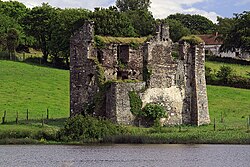Difference between revisions of "Deeps Castle"
(Created page with "{{Infobox castle |name=Deeps Castle |county=Wexford |picture=Castles of Leinster, Deeps, Wexford (1) - geograph.org.uk - 3036315.jpg |picture caption= |os grid ref=S98172725 |...") |
(No difference)
|
Revision as of 19:47, 10 June 2024
| Deeps Castle | |
|
County Wexford | |
|---|---|

| |
| Type: | Tower house |
| Location | |
| Grid reference: | S98172725 |
| Location: | 52°23’18"N, 6°33’31"W |
| Village: | Killurin |
| History | |
| Built 14th or 15th century | |
| Information | |
| Condition: | Ruinous |
Deeps Castle is a late-Norman castle in County Wexford. It is in the form of a square-built tower house, standing at the Deeps on the edge of the River Slaney. It stands beside Killurin and in the parish of Crossabeg.
This castle is in ruins. It remains though notable as one of the few remaining examples of a tower house of its kind.
History
Deeps, or 'Dipps', was in the possession of the Beaumont family in the Middle Ages, but was restored to the Crown in 1485. Before the Beaumonts it may have been held by the Roches. The tower house was probably built in the 14th century.
By the 17th century, the castle was held by the Devereux family, and most of the ruin belongs to that period.
Whether Deeps Castle saw action in the Cromwellian reconquest of Ireland is uncertain. After the Cromwellian War, the castle was held by the Randall family, who were Quakers.
Forty years later in 1690, William of Orange fought and defeated his father-in-law, the deposed King James II, at the Battle of the Boyne, and after the battle James is said to have stayed in hiding at the Deeps Castle before taking ship to France.
The castle itself has since fallen into disrepair. The main chimney in the south wall collapsed into the building, weakening the entire structure and altering the distinctive skyline of the area.[1]
Outside links
- Deeps Castle
- Deeps Castle: Megalithic Ireland
References
- ↑ "History of the Deeps Castle". http://www.deepscastle.com/history.html. Retrieved 2013-09-12.